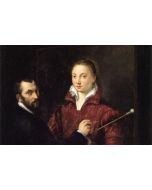Art in 1920s Paris
This course will be delivered online. See the ‘What is the course about?’ section in course details for more information.
Sorry, this course is now full
- Course Code: VB783
- Dates: 04/06/24 - 02/07/24
- Time: 13:30 - 15:30
- Taught: Tue, Daytime
- Duration: 5 sessions (over 5 weeks)
- Location: Online
- Tutor: Sarah Jaffray
Course Code: VB783
Duration: 5 sessions (over 5 weeks)
Please note: We offer a wide variety of financial support to make courses affordable. Just visit our online Help Centre for more information on a range of topics including fees, online learning and FAQs.
What is the course about?
In the wake of World War I and the resolution of plague, we find the Lost Generation - the people who survived what felt like the apocalyse. In their world of uncertainty, in a city of creativity, these artists were free to experiment and suggest new ways to live. This short-course explores the Lost Generation and their work within the École de Paris. The École de Paris (School of Paris) is not a particular institution, but the description of the city itself as a school for art. With its cafés, fashions, and political histories the entire city was a great source of creative inspiration. The focus of this course is not on a chronology of 'isms', but the ways in which Paris, its milieu, was an active co-creator of art.
We cover surrealism and some of its key artists of the 1920s, including André Breton and Man Ray. We look at distinctive painters like Marc Chagall, Tamara Lempicka, Marie Laurencin and Foujita as well as sculptors Constantin Brancusi and Jacques Lipchitz. We also look at artists who defy categorisation like Mina Loy, Sonia Delaunay and Max Ernst. Finally, the course includes the influence of the models, collectors and poets who supported and shaped the work of these artists. People like Kiki de Montparnasse, Ambroise Vollard, Robert Desnos and Marcel Duchamp were some of those integral to the art that blurred the borders and boundaries set by the previous cultural traditions.
This is a live online course. You will need:
- Internet connection. The classes work best with Chrome.
- A computer with microphone and camera is best (e.g. a PC/laptop/iMac/MacBook), or a tablet/iPad/smart phone/iPhone if you don't have a computer.
- Earphones/headphones/speakers.
We will contact you with joining instructions before your course starts.
What will we cover?
-Surrealism, its origins and experimental practices
-École de Paris (School of Paris) and its various artists and exhibitions
-Experimental film and photography of the era
-The broader artistic circles, including influential models and collectors.
What will I achieve?
By the end of this course you should be able to...
-Explain how the historical context of 1920s Paris relates to the art of the period
-Discuss the art practice of at least two artists featured in this course
-Understand the purpose/style of the different movements (or isms) discussed in this course.
What level is the course and do I need any particular skills?
This course is suitable for all levels. You should be able to follow simple written and verbal instructions, demonstrations, hand-outs and health and safety information as well as basic functions of Zoom, specifically microphone and camera.
The course includes optional readings that some learners may find challenging because it uses art terminology and theory.
How will I be taught, and will there be any work outside the class?
You will be taught with a combination of lecture (with powerpoint slides), discussion and group activities. There will be homework. Homework changes each week, but generally takes the form of readings, watching videos or looking at works of art and is designed to take no more than 30 minutes outside of class each week.
This course has a Google Classroom where we share documents and course materials.
In additional to live lecture via Zoom, you will be asked to join a Google Classroom where documents and course materials will be shared.
Are there any other costs? Is there anything I need to bring?
There are no additional costs. You may wish to purchase a notebook for your course materials.
When I've finished, what course can I do next?
Visionary Experiments: American art of the 1940s and 50s
Modern Art in America: the Ashcan School to Precisionism
Modern Art in America: the age of Hopper, Rivera and the New Deal
Makers not muses: Claude Cahun, Eileen Agar and Isabel Rawsthorne.
Sarah Jaffray holds a BA and MA in Art History with an emphasis in 19th/20th century France and a minor in the Italian Renaissance. She holds a second MA in Cultural Theory from Goldsmiths, University of London. Sarah was a lecturer for several colleges and universities in the Los Angeles area before relocating to London in 2012. She has worked in curatorial roles at the British Museum and Wellcome Collection. In addition to her current teaching at City Lit, Sarah is a lecturer at the University of Arts London and the Tutor Coordinator for City Lit's Art History programme. Her art historical practice focuses on experimental narratives, artistic process, art pedagogy, politics and philosophy. Sarah's current research is focused on translation and empathy.
Please note: We reserve the right to change our tutors from those advertised. This happens rarely, but if it does, we are unable to refund fees due to this. Our tutors may have different teaching styles; however we guarantee a consistent quality of teaching in all our courses.
